Mortality Differentials by Race
ORES Working Paper No. 99 (released December 2002)
In the 2001 report of the President's Commission to Strengthen Social Security, the commission states that blacks "on average have both lower incomes and shorter life expectancies than other Americans." This paper examines the extent to which the shorter life expectancies of blacks are explained by differences between their average socioeconomic status and that of other Americans.
Estimates in this paper for men aged 25 to 64 show that about half of the difference in risk of death between blacks and all other races was explained by education level—the measure of socioeconomic status employed. At ages 65 to 90, black men were not found to have a significantly higher risk of death than men of all other races.
The author is with the Division of Economic Research, Office of Research, Evaluation, and Statistics, Office of Policy, Social Security Administration.
Acknowledgments: The author would like to thank Susan Grad and Joyce Manchester for their helpful comments and suggestions and Bert Kestenbaum for having the foresight to update the 1973 Exact Match, without which this analysis would not be possible.
Working papers in this series are preliminary materials circulated for review and comment. The findings and conclusions expressed in them are the authors' and do not necessarily represent the views of the Social Security Administration.
Summary
There is disagreement in the differential mortality literature over whether adverse mortality differentials by race persist after accounting for differences in socioeconomic status between blacks and whites. Some studies find that differences in life expectancy by race are reduced but are still present after controlling for socioeconomic status; other studies find that such differences are eliminated.
In part, the lack of consensus may be due to limitations of race data. The sample size of some racial groups is often small, which can cause estimates to vary widely. Categories of race and ethnicity have changed several times on surveys, complicating the study of trends over time. In addition, some studies have found that death reporting is less accurate for blacks, particularly at older ages (Elo and Preston 1994). In fact, the authors (1994, 427) conclude that "conventionally constructed African-American death rates may be seriously flawed as early as age 50."
Calculations of life expectancy by race are also sensitive to the age from which life expectancy is measured. Researchers have consistently found that the largest gap in black and white mortality rates occurs at young ages. In fact, several studies have found that differences in life expectancy by race—after accounting for socioeconomic status—are present at ages 25 to 64 and are not present at ages 65 or older. However, it is not known how much this finding is affected by inaccurate death reporting for blacks at older ages.
Estimates in this paper for men aged 25 to 64 show that about half of the difference in risk of death between blacks and all other races was explained by education level—the measure of socioeconomic status employed. In terms of magnitude, after controlling for both race and education, the predicted odds of death for black men were 1.3 times the predicted odds of death of all other sample respondents, the predicted odds of death for men with less than 12 years of education were 2.6 times the odds of death for the college educated, and the predicted odds of death for men with 12 to 15 years of education were 1.6 times the predicted odds for the college educated. At ages 65 to 90, black men were not found to have a significantly higher risk of death than men of all other races.
Brief Overview of Selected Studies
Several studies find that mortality differentials by race persist, after controlling for socioeconomic status and other variables frequently linked to mortality, but that the magnitude of those differentials is reduced. For example, when Lillard and Panis (1996, 8) control for marital status and household income, the difference in expected age at death between black and white men as of their 25th birthday falls from 4.4 years to 1.4 years. Elo and Preston (1996, 56) find that at ages 25 to 64, 54 percent of the higher mortality risk of black men and 39 percent of the adverse mortality risk of black women is explained by socioeconomic variables. In that study, the authors control for family income, education, marital status, household size, region of birth, and current residence. Controlling for the same factors, they do not find significant mortality differences for black men or black women aged 65 to 89. In a 1994 study, however, they find substantial age misreporting for blacks at older ages. Similarly, Sorlie, Backlund, and Keller (1995, 951) find the magnitude of mortality risk among blacks aged 25 to 44 and 45 to 64 is reduced but is still significantly higher than that of whites, after controlling for age, employment status, income, and education. The authors do not find a mortality risk differential by race for ages 65 or older—except for men and women in the "other" (nonwhite, nonblack) category who show lower mortality risk than blacks and whites. Sorlie and others (1992) find that controlling for family income reduces the adverse mortality risk by 35 percent for black men aged 25 to 44 and by 55 percent for those aged 45 to 64. They cite several studies that have found lower use of medical services by blacks, controlling for age, sex, and income (pp. 349–350). When they examine relative mortality rates for black men after adjusting for income, they find that the mortality rate of blacks relative to whites is highest at ages 30 to 40; lower, but still positive, at ages 45 to 60; and approximately equal after age 65.
On the other hand, several studies have found that controlling for socioeconomic status eliminates mortality differentials by race. For example, Menchik (1993, 435) finds that controlling for economic and environmental variables reduces by 75 percent mortality risk for black men aged 45 to 59; the race differential is no longer statistically significant but is still positive. Rogers (1992, 296) finds that controlling for age, sex, marital status, family size, and income erases differences in mortality risk between blacks and whites aged 25 or older. He also examines cause-specific mortality rates after controlling for socioeconomic variables. Rogers (1996, 297) finds that blacks have a higher probability of dying from diabetes, homicide, and infectious diseases; an equal probability of dying from circulatory disease and cancer; and a lower probability of dying from accidents, respiratory diseases, and suicide. Lillard and Panis (1998) find that black men aged 25 or older are not at higher risk of death than are white men once education, marital status, and permanent income are controlled for. McDonough and others (1997, 1481) find that the effect of being black on mortality among persons aged 45 or older disappears when controlling for income. However, they note that this result should be interpreted with caution.
Evidence from the 1973 Exact Match
The 1973 Exact Match is a 1973 Current Population Survey (CPS) matched to Social Security administrative records through 1998. Deaths are observed in the administrative data from 1973 to 1997, so the 1973 Exact Match provides a fairly large sample of deaths for mortality estimates. In the 1973 Exact Match, level of education and marital status explain about half of the difference in mortality risk between blacks and all other races. Controlling for education and marital status lowers the odds of dying for blacks relative to all other races from 58 percent to 30 percent for ages 25 to 64 and from 21 percent to 9 percent for ages 65 to 90 (see Tables 1 and 2, equations 1 and 3). At ages 65 to 90, black men do not have significantly higher mortality risk than white men, after controlling for education. However, in previous research on the 1973 Exact Match using a more restrictive sample (it excluded Social Security Disability Insurance beneficiaries), the predicted odds of dying were 17 percent greater for black men than for all other men—a statistically significant result (Waldron 2001). The fact that statistical significance changes with a change in sample composition illustrates the high variance of the race variable. Note that even when race was significant at older ages, the increase in the log odds of dying for black men relative to all other men ranged from 3 percent to 32 percent, demonstrating the wide variance of the point estimate (Waldron 2001).
| Variable | Equation 1 | Equation 2 | Equation 3 | |||
|---|---|---|---|---|---|---|
| Parameter estimate |
Odds ratio | Parameter estimate |
Odds ratio | Parameter estimate |
Odds ratio | |
| Intercept | 18.7401 (15.3845) |
. . . | 26.5075 (15.4321)** |
. . . | 14.8892 (15.4857) |
. . . |
| Age | 0.0684 (0.00446)* |
1.071 (1.062-1.08) |
0.0686 (0.00446)* |
1.071 (1.062-1.08) |
0.0691 (0.00446)* |
1.071 (1.062-1.081) |
| Year of birth | -0.0141 (0.00787)** |
0.986 (0.971-1.001) |
-0.018 (0.00789)* |
0.982 (0.967-0.997) |
-0.0123 (0.00792) |
0.988 (0.973-1.003) |
| Black a | 0.46 (0.0951)* |
1.584 (1.315-1.909) |
0.4177 (0.0956)* |
1.519 (1.259-1.831) |
0.2609 (0.0968)* |
1.298 (1.074-1.569) |
| Married in 1973 | . . . | . . . | -0.3898 (0.0767)* |
0.677 (0.583-0.787) |
-0.3806 (0.0767)* |
0.683 (0.588-0.794) |
| Education (years) | ||||||
| Less than 12 | . . . | . . . | . . . | . . . | 0.9481 (0.0987)* |
2.581 (2.127-3.132) |
| 12 to 15 | . . . | . . . | . . . | . . . | 0.4563 (0.094)* |
1.578 (1.313-1.897) |
| 16 or more | . . . | . . . | . . . | . . . | Reference variable |
Reference variable |
| SOURCE: Author's calculations using data from the 1973 Exact Match. | ||||||
| NOTES: . . . = not applicable. | ||||||
| * = standard error significant at the 5 percent level. | ||||||
| ** = standard error significant at the 10 percent level. | ||||||
| a. Race differential narrows with age in an interaction not shown here. | ||||||
| Variable | Equation 1 | Equation 2 | Equation 3 | |||
|---|---|---|---|---|---|---|
| Parameter estimate |
Odds ratio | Parameter estimate |
Odds ratio | Parameter estimate |
Odds ratio | |
| Intercept | 19.963 (5.4639)* |
. . . | 18.5246 (5.4661)* |
. . . | 8.8557 (5.5564)** |
. . . |
| Age | 0.0752 (0.00285)* |
1.078 (1.072-1.084) |
0.0757 (0.0028)* |
1.079 (1.073-1.085) |
0.0767 (0.00285)* |
1.08 (1.074-1.086) |
| Year of birth a | -0.0149 (0.0028)* |
0.985 (0.980-0.991) |
-0.014 (0.0028)* |
0.986 (0.981-0.992) |
-0.00918 (0.00285)* |
0.991 (0.985-0.996) |
| Black | 0.1909 (0.0547)* |
1.21 (1.087-1.347) |
0.1633 (0.055)* |
1.177 (1.057-1.311) |
0.0835 (0.0556) |
1.087 (0.975-1.212) |
| Married in 1973 | . . . | . . . | -0.2524 (0.0414)* |
0.777 (0.716-0.843) |
-0.2317 (0.0415)* |
0.793 (0.731-0.860) |
| Education (years) | ||||||
| Less than 12 | . . . | . . . | . . . | . . . | 0.4602 (0.0496)* |
1.584 (1.438-1.746) |
| 12 to 15 | . . . | . . . | . . . | . . . | 0.2323 (0.0508)* |
1.262 (1.142-1.394) |
| 16 or more | . . . | . . . | . . . | . . . | Reference variable | Reference variable |
| SOURCE: Author's calculations using data from the 1973 Exact Match. | ||||||
| NOTES: . . . = not applicable. | ||||||
| * = standard error significant at the 5 percent level. | ||||||
| ** = standard error significant at the 10 percent level. | ||||||
| a. yob * (<12 years of education) and yob * (12–15 years of education) significant in an interaction not shown here. | ||||||
The difference in magnitude between race differentials and education differentials is shown in Chart 1, which depicts the odds ratio reported in Tables 1 and 2, equation 3. For men aged 25 to 64, the predicted odds of death for those with less than 12 years of education were 2.6 times the odds of death for the college educated, the predicted odds of death for those with 12 to 15 years of education were 1.6 times the odds of death of the college educated, and the predicted odds of death for blacks were 1.3 times the odds of all other sample respondents. The magnitude of mortality differentials is lowered at older ages. Among all men aged 65 to 90, the predicted odds of death for those with less than 12 years of education were 1.6 times the odds for the college educated, the predicted odds of death for those with 12 to 15 years of education were 1.3 times the odds for the college educated, and the predicated odds of death for blacks were 1.1 times the predicted odds of death for all other sample respondents (but not significantly so). Note that for men aged 25 to 64, the lower bound of the odds ratio for being black is 1.1 and the lower bound of the odds ratio for having 12 to 15 years of education is 1.3, highlighting the greater power of the education variables in explaining mortality differences between men.
Odds ratios for men aged 25 to 64 and 65 to 90, by educational attainment
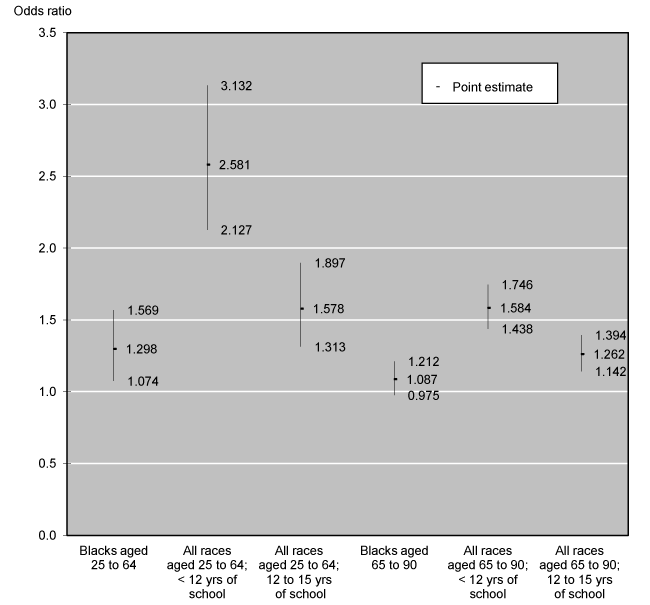
| Educational attainment | Odds ratio | ||
|---|---|---|---|
| High | Low | Point | |
| Blacks aged 25 to 64 | 1.569 | 1.074 | 1.298 |
| All races aged 25 to 64; less than 12 years of school | 3.132 | 2.127 | 2.581 |
| All races aged 25 to 64; 12 to 15 years of school | 1.897 | 1.313 | 1.578 |
| Blacks aged 65 to 90 | 1.212 | 0.975 | 1.087 |
| All races aged 65 to 90; less than 12 years of school | 1.746 | 1.438 | 1.584 |
| All races aged 65 to 90; 12 to 15 years of school | 1.394 | 1.142 | 1.262 |
The point estimate on race for ages 25 to 64 may be slightly misleading because an interaction of race with age is significant in that age range and narrows the differential between blacks and all other races as individuals in the sample move from age 25 to age 64. The widest mortality differential appears at age 25 and narrows quite a bit by age 45 (illustrated in Chart 2). The crossover at age 55 is not significant and should be interpreted as showing that the differentials are statistically indistinguishable at ages 55 to 60. Note that the ambiguous quality of race data makes it unclear how much of this age interaction is a reflection of actual events and how much is a reflection of measurement error.
Mortality differentials at ages 25 to 60 for unmarried black men and all other unmarried men born in 1940 with less than 12 years of school
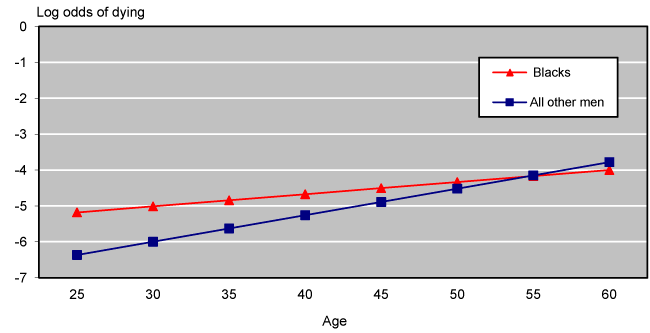
| Age | Blacks | All other men |
|---|---|---|
| 25 | -5.1816 | -6.3673 |
| 30 | -5.0126 | -5.9978 |
| 35 | -4.8436 | -5.6283 |
| 40 | -4.6746 | -5.2588 |
| 45 | -4.5056 | -4.8893 |
| 50 | -4.3366 | -4.5198 |
| 55 | -4.1676 | -4.1503 |
| 60 | -3.9986 | -3.7808 |
Trends in Educational Attainment Over Time
Since a large portion of the difference in average life expectancy at age 25 between black men and all other men is explained by differences in average educational achievement, it is instructive to examine how differences in the level of schooling between those groups have been changing over time. Overall, black men no longer complete high school at lower rates than do white men, but white men still complete college at greater rates than do black men. For the 1908–1910 birth cohort, 22 percent more black men did not complete high school; for the 1968–1970 birth cohort, slightly more white men were high school dropouts (see Chart 3).1 Note that the average difference in high school completion by race did not drop below 10 percent until the 1941–1943 birth cohort and was not eliminated until the 1959–1961 birth cohort. The percentage of black men with 12 to 15 years of education surpassed the percentage of their white counterparts beginning with the 1944–1946 birth cohort. The reason is that the percentage of white men completing college sharply increased in this time period. The percentage of white men obtaining a bachelor's degree has since dropped from its peak during the Vietnam War era, but there are still about 12 percent more white men than black men with a bachelor's degree for the 1968–1970 birth cohort (see Charts 4 and 5).
Educational attainment (less then 12 years of school) of white and black men, by birth cohort
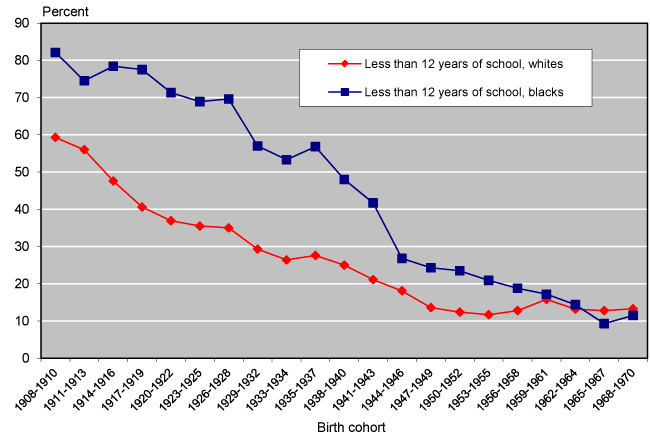
| Birth cohort | Whites | Blacks |
|---|---|---|
| 1908–1910 | 59.3 | 82.1 |
| 1911–1913 | 56.0 | 74.5 |
| 1914–1916 | 47.6 | 78.4 |
| 1917–1919 | 40.6 | 77.5 |
| 1920–1922 | 36.9 | 71.3 |
| 1923–1925 | 35.5 | 68.9 |
| 1926–1928 | 35.0 | 69.6 |
| 1929–1932 | 29.3 | 57.0 |
| 1933–1934 | 26.4 | 53.3 |
| 1935–1937 | 27.6 | 56.8 |
| 1938–1940 | 25.0 | 48.0 |
| 1941–1943 | 21.1 | 41.7 |
| 1944–1946 | 18.1 | 26.8 |
| 1947–1949 | 13.6 | 24.3 |
| 1950–1952 | 12.4 | 23.5 |
| 1953–1955 | 11.7 | 20.9 |
| 1956–1958 | 12.8 | 18.8 |
| 1959–1961 | 15.8 | 17.2 |
| 1962–1964 | 13.2 | 14.4 |
| 1965–1967 | 12.8 | 9.3 |
| 1968–1970 | 13.3 | 11.5 |
Educational attainment (12–15 years of school) of white and black men, by birth cohort
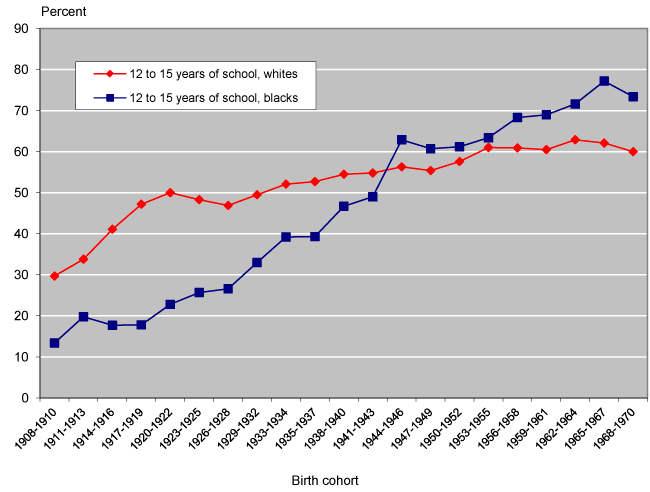
| Birth cohort | Whites | Blacks |
|---|---|---|
| 1908–1910 | 29.7 | 13.4 |
| 1911–1913 | 33.8 | 19.8 |
| 1914–1916 | 41.1 | 17.7 |
| 1917–1919 | 47.2 | 17.8 |
| 1920–1922 | 50.0 | 22.8 |
| 1923–1925 | 48.3 | 25.7 |
| 1926–1928 | 46.9 | 26.6 |
| 1929–1932 | 49.5 | 33.0 |
| 1933–1934 | 52.1 | 39.2 |
| 1935–1937 | 52.7 | 39.3 |
| 1938–1940 | 54.5 | 46.7 |
| 1941–1943 | 54.8 | 49.0 |
| 1944–1946 | 56.3 | 62.9 |
| 1947–1949 | 55.4 | 60.7 |
| 1950–1952 | 57.6 | 61.2 |
| 1953–1955 | 61.0 | 63.4 |
| 1956–1958 | 60.9 | 68.3 |
| 1959–1961 | 60.5 | 69.0 |
| 1962–1964 | 62.9 | 71.6 |
| 1965–1967 | 62.1 | 77.2 |
| 1968–1970 | 60.0 | 73.4 |
Educational attainment (16 or more years of school) of white and black men, by birth cohort
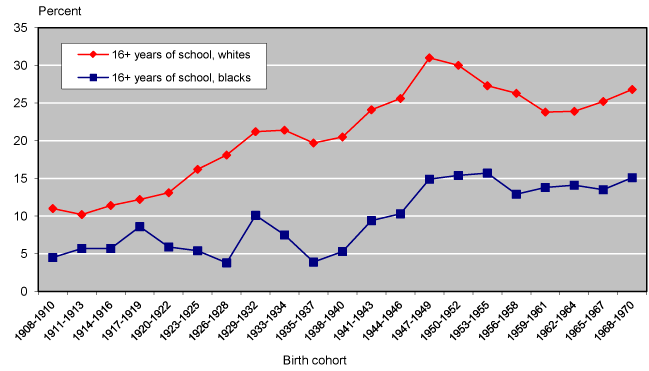
| Birth cohort | Whites | Blacks |
|---|---|---|
| 1908–1910 | 11.0 | 4.5 |
| 1911–1913 | 10.2 | 5.7 |
| 1914–1916 | 11.4 | 5.7 |
| 1917–1919 | 12.2 | 8.6 |
| 1920–1922 | 13.1 | 5.9 |
| 1923–1925 | 16.2 | 5.4 |
| 1926–1928 | 18.1 | 3.8 |
| 1929–1932 | 21.2 | 10.1 |
| 1933–1934 | 21.4 | 7.5 |
| 1935–1937 | 19.7 | 3.9 |
| 1938–1940 | 20.5 | 5.3 |
| 1941–1943 | 24.1 | 9.4 |
| 1944–1946 | 25.6 | 10.3 |
| 1947–1949 | 31.0 | 14.9 |
| 1950–1952 | 30.0 | 15.4 |
| 1953–1955 | 27.3 | 15.7 |
| 1956–1958 | 26.3 | 12.9 |
| 1959–1961 | 23.8 | 13.8 |
| 1962–1964 | 23.9 | 14.1 |
| 1965–1967 | 25.2 | 13.5 |
| 1968–1970 | 26.8 | 15.1 |
The median annual earnings of college graduates have been rising relative to those of high school graduates since 1980 (see Chart 6). How this will translate into mortality risk differences between the black and white population depends in part on whether education affects mortality through its impact on lifetime earnings, through the beneficial effects of a higher level of education on one's ability to learn healthy behaviors, or through its impact on an individual's relative (not absolute) rank in the income distribution. There is currently no consensus on this question.
Ratio of median annual earnings of college graduates aged 25 to 34 relative to high school graduates aged 25 to 34
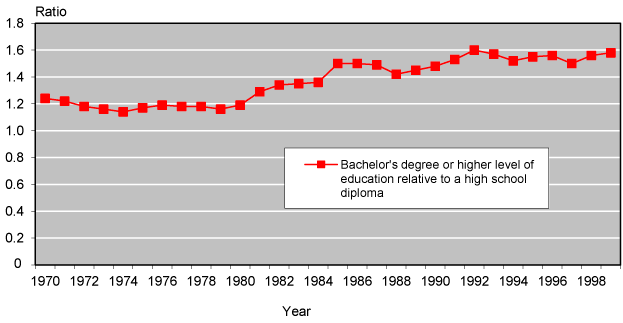
| Year | Ratio, bachelor's degree or higher level of education relative to a high school diploma |
|---|---|
| 1970 | 1.24 |
| 1971 | 1.22 |
| 1972 | 1.18 |
| 1973 | 1.16 |
| 1974 | 1.14 |
| 1975 | 1.17 |
| 1976 | 1.19 |
| 1977 | 1.18 |
| 1978 | 1.18 |
| 1979 | 1.16 |
| 1980 | 1.19 |
| 1981 | 1.29 |
| 1982 | 1.34 |
| 1983 | 1.35 |
| 1984 | 1.36 |
| 1985 | 1.5 |
| 1986 | 1.5 |
| 1987 | 1.49 |
| 1988 | 1.42 |
| 1989 | 1.45 |
| 1990 | 1.48 |
| 1991 | 1.53 |
| 1992 | 1.6 |
| 1993 | 1.57 |
| 1994 | 1.52 |
| 1995 | 1.55 |
| 1996 | 1.56 |
| 1997 | 1.5 |
| 1998 | 1.56 |
| 1999 | 1.58 |
Notes
1. In Charts 3–5, data for birth cohorts 1908 to 1934 are not directly comparable with data for birth cohorts 1935 to 1970. For birth cohorts 1908 to 1934, level of education is observed in 1973 at ages 39 to 65 in the 1973 Exact Match; for birth cohorts 1935 to 1970, level of education is observed at age 30 in the 1965 to 2000 Current Population Surveys, respectively. The education variable in the CPS for 1992 and later is not directly comparable with pre-1992 data; so after 1992, CPS education categories "38 to 42" are included here in the 12 to 15 years of education category.
References
Elo, Irma T., and Samuel H. Preston. 1994. "Estimating African-American Mortality from Inaccurate Data." Demography 31(3): 427–458.
———. 1996. "Educational Differentials in Mortality: United States, 1979–85." Social Science and Medicine 42(1): 47–57.
Lillard, Lee, and Constantijn W.A. Panis. 1996. "Socioeconomic Differentials in the Returns to Social Security." Contract report for RAND, Santa Monica, California. February.
———. 1998. "Income and Mortality: The Role of Health." Contract report for RAND, Santa Monica, California. February.
McDonough, Peggy; Greg J. Duncan; David Williams; and James House. 1997. "Income Dynamics and Adult Mortality in the United States, 1972 through 1989." American Journal of Public Health 87(9): 1476–1483.
Menchik, Paul L. 1993. "Economic Status as a Determinant of Mortality Among Black and White Older Men: Does Poverty Kill?" Population Studies 47: 427–436.
Rogers, Richard G. 1992. "Living and Dying in the U.S.A.: Sociodemographic Determinants of Death Among Blacks and Whites." Demography 29(2): 287–303.
Sorlie, Paul D.; Eric Backlund; and Jacob B. Keller. 1995. "U.S. Mortality by Economic, Demographic, and Social Characteristics: The National Longitudinal Mortality Study." American Journal of Public Health 85(7): 949–956.
Sorlie, Paul; Eugene Rogot; Roger Anderson; Norman J. Johnson; and Eric Backlund. 1992. "Black-White Mortality Differences by Family Income." The Lancet 340: 346–350.
U.S. Department of Education, National Center for Education Statistics. 2001. The Condition of Education 2001. NCES 2001–072. Washington, D.C.: U.S. Government Printing Office.
Waldron, Hilary. 2001. Links Between Early Retirement and Mortality. ORES Working Paper No. 93. Social Security Administration, Office of Policy, Office of Research, Evaluation, and Statistics. August.